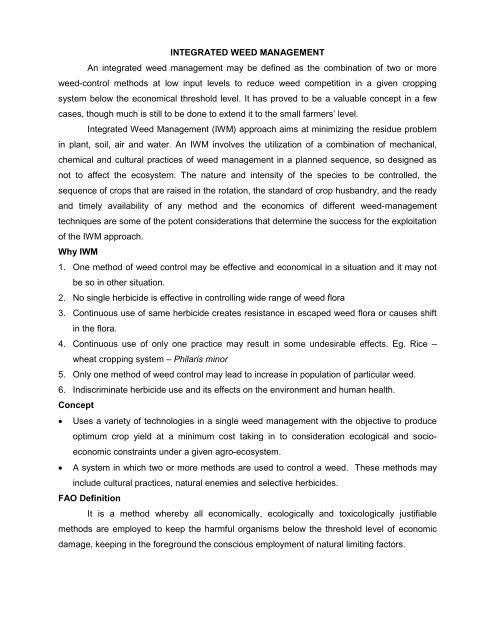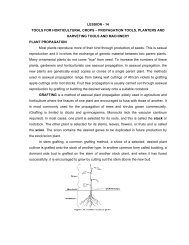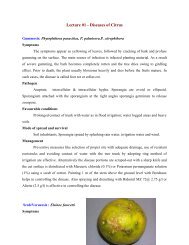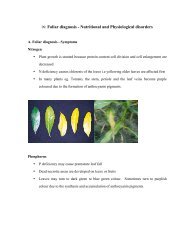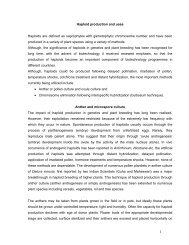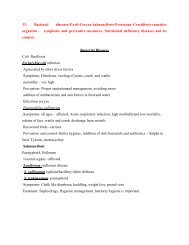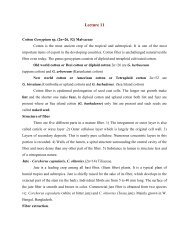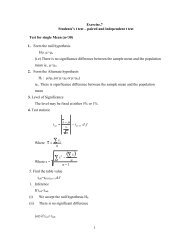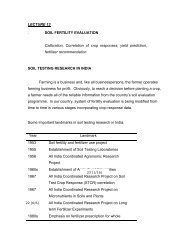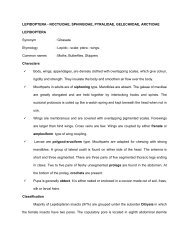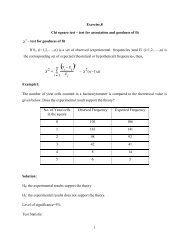Download this lecture as PDF here - TNAU
Download this lecture as PDF here - TNAU
Download this lecture as PDF here - TNAU
Create successful ePaper yourself
Turn your PDF publications into a flip-book with our unique Google optimized e-Paper software.
INTEGRATED WEED MANAGEMENTAn integrated weed management may be defined <strong>as</strong> the combination of two or moreweed-control methods at low input levels to reduce weed competition in a given croppingsystem below the economical threshold level. It h<strong>as</strong> proved to be a valuable concept in a fewc<strong>as</strong>es, though much is still to be done to extend it to the small farmers’ level.Integrated Weed Management (IWM) approach aims at minimizing the residue problemin plant, soil, air and water. An IWM involves the utilization of a combination of mechanical,chemical and cultural practices of weed management in a planned sequence, so designed <strong>as</strong>not to affect the ecosystem. The nature and intensity of the species to be controlled, thesequence of crops that are raised in the rotation, the standard of crop husbandry, and the readyand timely availability of any method and the economics of different weed-managementtechniques are some of the potent considerations that determine the success for the exploitationof the IWM approach.Why IWM1. One method of weed control may be effective and economical in a situation and it may notbe so in other situation.2. No single herbicide is effective in controlling wide range of weed flora3. Continuous use of same herbicide creates resistance in escaped weed flora or causes shiftin the flora.4. Continuous use of only one practice may result in some undesirable effects. Eg. Rice –wheat cropping system – Philaris minor5. Only one method of weed control may lead to incre<strong>as</strong>e in population of particular weed.6. Indiscriminate herbicide use and its effects on the environment and human health.Concept• Uses a variety of technologies in a single weed management with the objective to produceoptimum crop yield at a minimum cost taking in to consideration ecological and socioeconomicconstraints under a given agro-ecosystem.• A system in which two or more methods are used to control a weed. These methods mayinclude cultural practices, natural enemies and selective herbicides.FAO DefinitionIt is a method w<strong>here</strong>by all economically, ecologically and toxicologically justifiablemethods are employed to keep the harmful organisms below the threshold level of economicdamage, keeping in the foreground the conscious employment of natural limiting factors.
IWM is the rational use of direct and indirect control methods to provide cost-effectiveweed control. Such an approach is the most attractive alternative from agronomic, economicand ecological point of view.Among the commonly suggested indirect methods are land preparation, watermanagement, plant spacing, seed rate, cultivar use, and fertilizer application. Direct methodsinclude manual, cultural, mechanical and chemical methods of weed control.The essential factor in any IWM programme is the number of indirect and direct methodsthat can be combined economically in a given situation. For example, incre<strong>as</strong>ed frequency ofploughing and harrowing does not eliminate the need for direct weed control. It is, t<strong>here</strong>fore,more cost-effective to use fewer pre-planting harrowing and combine them with direct weedcontrol methods.T<strong>here</strong> is experimental evidence that illustrates that better weed control is achieved ifdifferent weed control practices are used in combination rather than if they are appliedseparately.Good IWM should bea. Flexible enough to incorporate innovations and practical experiences of local farmers.b. Developed for the whole farm and not for just one or two fields and hence it should beextended to irrigation channels, road sides and other non-crop surroundings on the farmfrom w<strong>here</strong> most weeds find their way in to the crop fields.c. Economically viable and practically fe<strong>as</strong>ible.Advantages of IWM• It shifts the crop-weed competition in favour of crop• Prevents weed shift towards perennial nature• Prevents resistance in weeds to herbicides• No danger of herbicide residue in soil or plant• No environmental pollution• Gives higher net return• Suitable for high cropping intensityIWM of Cuscuta in Lucerne1. In fields with history of Cuscuta (dodder), adopt crop raotations with non-susceptiblecrops. Grow lucerne only once in three years in such fields.2. Do not move animals and machinery from the dodder infested fields to the new ones.3. Treat densely infested patches of lucerne with a non-residue herbicide like paraquat.4. Do not feed the cuscuta infested crop to the animals.5. Do not collect the lucerne seeds from the crop infested with dodder.


